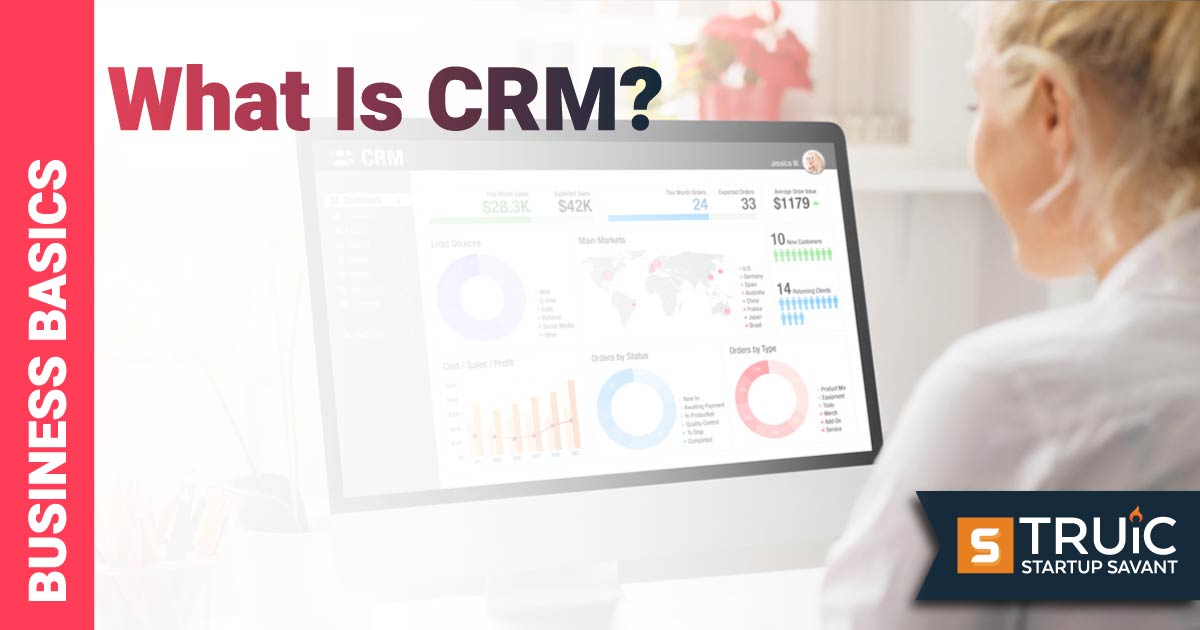What Is CRM?
A Guide to Customer Relationship Management

Last Updated: By Mark Shalinsky
You’ve started your business-to-business (B2B) startup, and you are getting customers — time to figure out how to develop and manage those relationships. In other words, it is time to get a customer relationship management (CRM) system. In this guide, we will discuss what a CRM is so you and your team can make an informed decision on whether or not you need a CRM and what type of CRM would be best for your organization at this time.
Looking for the right CRM system for your company? Visit our review of the best CRM for startups!
CRM 101
What Is CRM?
Is it a spreadsheet? Is it a Rolodex? Is it for opportunity tracking? Is it a receipt shoebox? Yes, yes, yes, and yes. A CRM can be all that and more; however, it can be an overwhelming piece of software, and selecting the right one for your company is key to achieving growth.
All that being said, if your organization has a single salesperson with a couple of dedicated clients and no discernible outbound efforts, a spreadsheet could work just fine. If you are looking to scale your outbound process, have a reasonable amount of inbound leads, want to keep yourself organized, and provide metrics to your colleagues, a bona fide CRM would be for you.
For small to medium-sized companies, the CRM becomes the database of record.
This means the CRM becomes the database that has the most accurate and relevant information pertaining to prospective customers in the sales process. For this reason, a CRM should contain key information pertaining to customer management.
What Does a CRM System Do?
A CRM should fulfill three basic functions:
- Lead management: the collection of all information pertaining to a lead.
- Task management: all the activities both leads and company representatives perform.
- Pipeline management: managing the buying intentions of the prospective customer.
Together, a CRM provides a holistic view of how your company identifies, tracks, and works with prospects on their journey to becoming one of your customers. Within the company, a CRM helps their marketing, sales, and customer success representatives become more effective and efficient with their time and efforts. A CRM helps keep your prospect and customer-facing personnel organized, on task, and up to date. Concurrently, when there is a playbook that is followed by all, management can easily identify what’s working (and what isn’t) and help make adjustments to the marketing, sales, and onboarding processes before they become larger issues.
Any CRM on the market today typically has a primary focus.
For instance, if you wanted a CRM focusing on task management, we’d recommend something like Monday.com.
If you’d like something for pipeline management, Salesforce is worth a try.
For lead management, a platform built off a marketing automation platform such as HubSpot, Pipedrive, or SharpSpring would be your best bet.
A secondary consideration for your CRM would be the interconnectivity of your CRM with the rest of your technological ecosystem. A company’s technological ecosystem is considered to be its “technology stack” or “tech stack” for short.
The tech stack typically comprises all their marketing, sales, customer success, finance, and account software. Usually, those technologies are connected via an application program interface (API) so that the data and information can be easily passed between the systems, thus reducing the need for double entry in multiple systems and reducing errors.
For smaller companies, this is not an issue as their technology stack is not particularly large or diverse. This interconnectivity becomes a major issue as a company scales — they add multiple platforms, and data handling becomes an issue.
For instance, in regulated industries such as the mortgage industry, some CRMs do not have APIs (application programming interfaces) that allow for the easy passage of information between two or more platforms.
On the other hand, if you are looking for all the most interesting and advanced sales and marketing software-as-a-service (SaaS) tools, many of those newer platforms only have API connections with the most common CRMs and marketing automation platforms such as Salesforce, MS Dynamics, and Hubspot. If you are lucky, they will have connections via Zapier or TexAu; both are considered universal connectors. This means that while a smaller CRM may fit the bill, for your organization to gain access to those new technologies, you may be required to purchase a more standard CRM.
Lead Management in CRM
With all the different functions a CRM can do, the most important aspect is customer relationship management, hence the name CRM. This means that the CRM should contain all the relevant and pertinent information of each and every prospect and customer.
Typically a sales representative will collect the following information from their prospects that will be logged into the CRM:
- First name
- Last name
- Phone number (sometimes multiple phone numbers such as direct and mobile)
- Email (this is usually a required field and is unique to each prospect, especially with CRMs closely tied to marketing automation such as HubSpot and SharpSpring).
- Title
- Company name
- An address
More advanced sales representatives or larger companies will collect other information pertaining to their prospects depending on how they are segmented, such as the number of employees, annual revenue, industry, SIC, or NAICS code, company shipping address, and billing address.
There are some interesting technology tools such as Infohive and Sigparser that help append and enhance the data in the CRM from the sales reps' emails so the sales representative can focus on what really matters — engaging with their prospects, not making errors while doing data entry.
Concurrently, there are some lead databases such as Zoominfo, Salesintel, Slintel, Apollo, and others that will do this and enhance tasks at a large scale across the entire organization. Again, the goal of prospect management is to free the sales reps up from all tasks that are not related to moving their prospect down a sales funnel.
Savvy organizations will also include relevant fields to help them segment and market to prospects that have fallen out of the sales process. Those fields may be parsed from fields already present, such as seniority or department both based on title parsing.
More advanced techniques using custom fields will allow an organization to build dynamic revenue models so they can better understand how different prospects move through their sales process.
Occasionally, sales representatives will request custom fields be added to their CRM so they can add notes on their prospects' personal interests and other pertinent information such as their LinkedIn, Instagram, Facebook, or TikTok posts, personal web pages, or even a link to their calendar.
Recommended CRM for Lead Management: HubSpot
CRM and Marketing Automation
The value of marketing information and data that is dropped into a CRM on the lead page for the sales rep to have easy access to is very high. When marketing and sales work together and have a single pane of glass of a prospect's activities, it helps tune the entire sales funnel. Marketing can develop more compelling collateral, and marketing can do better lead scoring. The result is that sales reps will only spend time with interested and engaged prospects, not the tire kickers.
Leads, Prospects, and Contacts
An interesting point to note is that within a CRM, individuals are labeled as either prospects, leads, or contacts, and depending on which CRM you are using, the definition may differ. For this reason, it is advised to understand how the data flows depending on which system you are planning to use.
In general, suspects, prospects, leads, and contacts are individuals that have not already purchased, whereas customers have already purchased something. Someone who has committed to purchase but has not purchased is not a customer.
Task Management
Being on top of prospects needs to be priority number one for any sales representative, and task management is the best way to stay on top of it.
Since time is the only commodity nobody is making more of, if a sales rep reaches an interested prospect, they should have a place where they can take and make notes regarding any conversation, pull in, and append any collateral (eg emails, documents, presentation), and figure out the next best day, time, how to reconnect, and follow-up with their prospect.
For leads whom the sales rep has not already had a conversation with, a sequence or cadence is the best way to set up tasks for the sales rep to follow.
A sequence or cadence, depending on the platform being followed, is a set of outbound steps or touches that may include emails, calls (and when to and not to drop voice mails), text messages, social media outreaches, sending physical gifts, etc. Typically a sequence or cadence is set up by an operations team (e.g,. sales or marketing), and outbound touches are measured by their effectiveness.
Steps or touches may be manual, such that the sales rep needs to take an action (for example, clicking on a link to bring them to a prospect’s LinkedIn page), automated (e.g., one day after a phone call was made, the sequencing system automatically sends an email), or a combination of the two (e.g., sales rep reviews the emails and makes personalized or relevancy adjustments prior to approving it to be sent out).
As sequences and cadences are critically important to being organized, there are a number of sales enablement platforms such as Outplay, Outreach, Salesloft, Koncert, and others that plug into the CRM that ensure the sales reps are on top of their prospects in a professionally persistent manner.
When prospects move into a sales cycle, and the pipeline is being managed, sequences and cadences still matter to a slightly lesser degree. Perhaps in a sales sequence, your legal department needs to send over contracts in a CRM that everyone has access to. As soon as your prospect moves to a specific stage in the sales process, the legal department representative can get notified.
Perhaps you have a customer success team with limited resources; they may block prospects from moving forward in the sales process as they would be unable to deliver success. On the other hand, if a sales representative has insight that their customer success department is getting overwhelmed, that can be an incentive to drive the prospect to close sooner, lest they miss a delivery window.
In short, a CRM that manages tasks for sales and sales supporting departments helps everyone stay on task and gain insights into how the company is functioning and ensures a smooth transition for the prospect as they are passed between departments throughout their customer journey.
Pipeline Management
The last, but definitely not least, important function a CRM needs to accomplish is aiding with pipeline management. What is pipeline management? This is the movement of prospects through the sales funnel, from an interested party to a purchasing consumer.
Typically the pipeline is defined as a funnel as there are more people who are interested in the products and or services than actual buyers of those products and or services, thus creating a natural tapering of people who move from the top of the funnel (interest) to the bottom of the funnel (purchase).
While the norm is that prospects move from the top of the funnel to the bottom, the typical case is that prospects move from the top to the bottom, back to the middle, and invariably bounce around the funnel until they either commit to buy or commit to not making any commitment.
The reason that prospects do not move in a smooth and linear line from top to bottom is is that there is so much information available to the buyer at any time, more so than ever before, so buyers are continually adding to their corpus of information which can push them from a buying decision back to a consideration mode.
That being said, most CRMs available today represent sales pipelines as either a funnel or Trello board.
The funnel, as described above, shows leads moving down a funnel with a tapering of leads as they move from interest to buying. The Trello board, on the other hand, is similar to a set of cards being moved from the left (general interest) to the right (purchasing).
Key points about pipeline management are not simply about moving sales opportunities to a purchasing action; similar to contact management, pipeline management is about collecting data.
Some key data points typically collected are:
- Current stage in pipeline
- Account associated with the opportunity
- Key people who are part of the opportunity on the buyer side
- Key people who are part of the opportunity on the seller side
- Contract value of the opportunity
- Expected date when the opportunity will close
Other information that organizations find important when collecting pipeline information can be:
- Which products are they interested in
- Time in each sales stage (e.g., start date and end date)
- How did they arrive in the pipeline (e.g., the channel source)
Data collected in the pipeline is valuable to several departments. As an example, marketing may be interested in the data so they can identify more prospects that are apt to buy. The finance department is interested in the data so they can develop revenue models and more adequately divide up the revenue share and forecast. The engineering department is interested in the data so they can see what prospects are interested in to better tailor their development roadmap.
Typically a CRM pipeline data is reconciled with accounting software so that both sales leadership and the accounting department are working off the same numbers. This is important so that sales leaders can easily identify top performers and weak players in order to create compensation plans accordingly.
Organizations where sales and accounting have different numbers, the numbers from the accounting department overrule, as they have direct access to the bank accounts and are thus the ultimate controllers of the purse strings.
Conclusion
Many organizations work very successfully without a CRM. However, when used properly, a CRM helps marketing, sales, and customer success teams punch above their weight class by keeping them organized, reducing oversight requirements, and helping management measure what matters. If you are interested in learning more about the nuances of different CRM systems and want to learn which CRM is best for you, please visit our review pages.
Next Steps: Check out our review of the best CRM for startups!
FAQ
What does CRM stand for?
CRM stands for customer relationship management.
What is a CRM?
A CRM is a database for marketing, sales, and customer success, to store their prospect and customer data marketing, track and assign tasks, and manage their sales pipeline.
Why do I need a CRM system?
A CRM helps keep your team organized and allows your team to monitor the process of selling products and interacting with clients. Learn more about whether or not you need a CRM.
What is the best CRM software?
The most selected CRMs are Salesforce, HubSpot, Monday, and Microsoft Dynamics. However, selecting a CRM is dependent on your needs and may be industry-specific.


